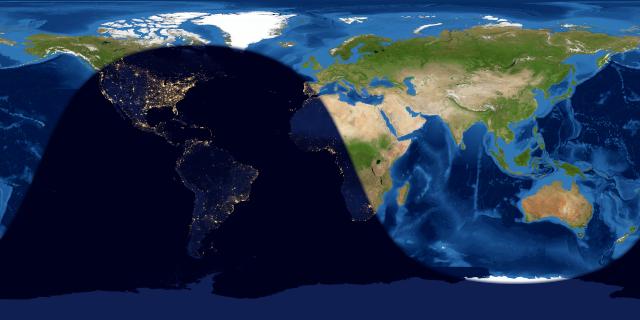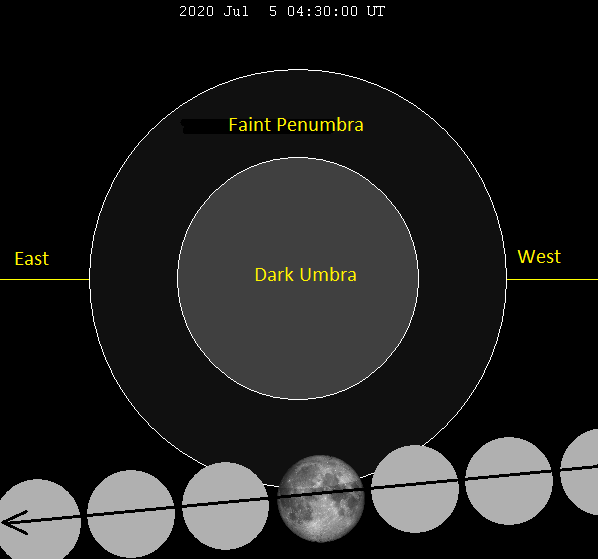For us in the Americas, the moon will turn precisely full during the nighttime hours on July 4-5, 2020, to present a partial penumbral eclipse of the moon. It’ll be such a faint eclipse – so nearly imperceptible – that some of you will swear nothing is happening even while staring straight at it. Then again … very observant people might notice something strange happening on the moon, even without knowing an eclipse is taking place. Who will see it (or not) in this post. But first …
On the night of July 4-5, there’s another astronomical event taking place that we all can see. This July full moon will shine near on the sky’s dome to the very bright planet Jupiter, and also to the ringed planet Saturn. You need a telescope to see Saturn’s rings. But you’ll get a kick out of seeing Jupiter and Saturn close together!
What’s more, Jupiter and Saturn are now at their best. Later this month, Earth will pass between each of these worlds and the sun, so that both Jupiter and Saturn reach their oppositions, Jupiter on July 13-14 and Saturn on July 20.
Don’t miss these worlds near the moon on July 4 and 5!
Read more: Jupiter at opposition on July 13-14, 2020
Read more: Saturn at opposition on July 20, 2020
Read more: Before 2020 ends, a great conjunction of Jupiter and Saturn
Now about that penumbral lunar eclipse on the night of July 4-5 … The eclipse happens for everyone at the same time worldwide. The time on your clock will depend on your location.


We in the Americas are well situated to view this extremely faint, partial penumbral eclipse of the moon on the night of July 4-5.
The chance is there … but will you notice anything even if you catch the eclipse? That depends in part on your eyesight, in part on your experience watching eclipses, and in part on your powers of observation.
So of course many will watch it! Just don’t be disappointed if it’s, shall we say, lacking in drama? At best, it’ll be a subtle shading on the moon.
This eclipse wins some distinction because it’s the third of three eclipses in one eclipse season. More often than not, an eclipse season only harbors two eclipses.
Read more: What is an eclipse season?
Read more: Middle of eclipse season June 20, 2020
To find eclipse times for your location for the July 4-5 eclipse, visit TimeandDate.com

What about the rest of the world? For most of the world’s Eastern Hemisphere, the moon will turn precisely full during daylight hours on July 5, when the moon is still below the horizon.
From the westernmost parts of Africa, people might spot this partial penumbral eclipse just before dawn July 5, but for most of the eclipse area in western Africa (and Spain and Portugal), the eclipse will be obscured by the glow of morning twilight. For reference, see the worldwide map above.
To find eclipse times for your location for the July 4-5 eclipse, visit TimeandDate.com

Astronomers say the moon is full when it’s precisely 180 degrees opposite the sun in ecliptic longitude. Although the moon turns full at the same instant worldwide, the time of day or local clock time of the full moon varies across the globe. Full moon happens on July 5 at 04:44 Universal Time. At United States time zones, that places the full moon at 12:44 a.m. EDT (on July 5) – yet on July 4 at 11:44 p.m. CDT, 10:44 p.m. MDT and 9:44 p.m. PDT.
Moon’s present position in front of the constellations of the zodiac via Heavens-Above
Generally speaking, half the globe won’t see the moon at the instant it turns precisely full. Still, from almost everywhere worldwide, the moon will appear plenty full to the eye on the nights of July 4-5 and 5-6. That’s because, for several days around full moon, the moon remains more or less opposite the sun and appears in Earth’s sky for most hours of the night.
Look for the moon to appear low in your eastern sky around sunset July 4. It’ll climb highest up for the night around midnight and will shine low in your western sky at dawn July 5. In other words, look for the moon to light up the sky from dusk till dawn.
The full moon lies almost opposite the sun, so the path of the July full moon across the nighttime sky will resemble that of the January sun across the daytime sky. Therefore, far-northern regions of the globe won’t see the moon at all these next few nights. That’s because the July full moon, like the January sun, resides too far south on the sky’s dome to be seen from northern Arctic latitudes.
In North America, we often call the July full moon the Buck Moon, Thunder Moon or Hay Moon. At this time of year, buck deer begin to grow velvety antlers, while farmers are working to put hay in their barns, and trying to avoid the summer season’s frequent thunder showers.

Bottom line: The penumbral lunar eclipse of July 4-5, 2020, will be so nearly imperceptible that some will see nothing even while staring at it. Then again … very observant people will notice a subtle shading on the moon, without knowing an eclipse is taking place.
To find eclipse times for your location for the July 4-5 eclipse, visit TimeandDate.com











